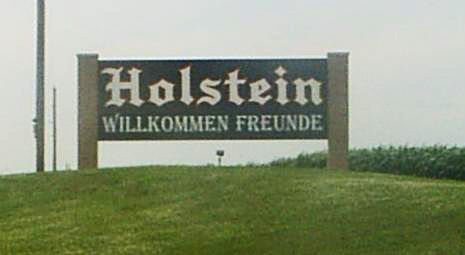
Ida County IAGenWeb

 |
Ida County IAGenWeb |
 |

History of HolsteinIn the BeginningNovember 10, 1882- The initial lots in Holstein were sold and the town platted. The first train had finally arrived that fall and vital transportation would now be available.Although the actual town of Holstein didn't become a reality until 1882, as early as 1868 pioneer farmers had been preparing the way. As numbers increased, it became more of a problem that the nearest facilities for grinding corn and wheat were in Cherokee or Ida Grove. In 1879, Mr. and Mrs. Henry Thielmann had purchased prairie land in Ida County one mile east and one mile north from the present town of Holstein. At this location a combination saloon. blacksmith shop, and dance hall was built. This area was widely known as the "German Settlement." as it was half-way between Ida Grove and Cherokee, it became a favorite shopping place for travelers, and while the railroad was being built, the Thielmanns often boarded 30-40 railroad men. Mr Thielmann also sold land -- Frederick Wm. werner, an early pioneer, told of buying his farm from H. Thielmann and of spending the long winter evenings at the saloon and dance hall. The largest group of land-owners in the area that would become Holstein included Davenport area residents, August and Ludvig Schmidt, who purchased eight sections of land from the Blairstown Lot and Land Company (A subsidiary of the Chicago and Northwestern Railway.) These men had been part of the hunting group who had seen the area in 1875. They encouraged other Davenport men to invest in this land, including Griggs, H. H. Andresen, Schneckloth, Claus and Hans Stoltenberg, Rochau, and Thies Sindt. In all, this group of men purchased 11,647 acres and formed the nucleus of the community that became Holstein. Finally in 1882, the railroad was completed through the area. The depot was built two miles from the "German Settlement." so the town was platted with First Street running parallel with the railroad. About a dozen lots were sold at auction with the highest price of $500 and the lowest $200. Among the purchasers were H.H. Lund of the firm King & Lund, G. W. Boszhardt, George Coolidge, J. Thode, W. H. Nolte, W. Reed, P. Bliesman, W. Bowman of the firm Bowman & Co., Lannard P. Stolley, and representatives of the Green Bay Lumber Co. Joachim Thode, one of the early settlers of the area, having arrived in 1876 with other settlers for New Holstein, Wisconsin, became the first mayor of Holstein. He also suggested that the name "Holstein" in honor of the province in Germany that had been the homeland for so many residents of the new town. The land that was chosen to become Holstein was thought of as swamp land. Nick von Doehren, builder of many of the first buildings of the town, erected the buildings on cedar blocks that rested on limestones thrown into the mud. The first store built was a general store owned by Herman Thode and George Coolidge. Other buildings followed quickly. Many of the first owners were men from Ida Grove who traveled back and forth over the deeply rutted trails on weekends. In 1882, J.T. Walker was one of the businessmen who located permanently- in fact, he was still in business in 1922. The first house in Holstein was built by Joseph and Amanda Kuchel in 1882 and the couple moved from a farm in Battle Township to their new home on Altoona Street in January of 1883. Also in 1883, Henry Thielmann's store was moved to town to join the growing number of business places in Holstein that included two hotels, six general stores, two hardware stores, four lumber yards, four elevators, one bank, one meat market,two harness shops, one barber, two blacksmiths, two livery barns, three doctors, one lawyer, two shoe shops, three wagon shops, one roller rink, and four saloons. At this time the population was about 400 The first school was one mile east of town. The story is told that several of the town fathers who wanted a school in town took it on themselves to move the school in the dark of night to a lot in town. It was not long, however, before Holstein citizens voted to build a $300 four-room school building on the ground given the town by August Schmidt, one of the original investors in the land from which Holstein was platted. At the same time, he gave land for a park and in 1884, trees and shrubbery had been planted. The first newspaper, The Holstein Bulletin, was published in 1884 by William Frank Hutton in both German and English. This paper didn't last long. Hutton then started the Holstein Advance in 1886. This paper was also published in German and English. The first church to be built in Holstein was the St. Paul Evangelical Lutheran Church in 1884. The congregation had been organized in 1883. The Catholic Church was organized in 1884 and the church built in 1886. The Methodist Church was organized in 1884 and the church built in 1887. In 1884, the Holstein Turnverein was organized by Henry Schneckloth. The Turner Society provided a unique opportunity for Holstein citizens to participate in gymnastic exercises, lectures, and dances. The "Turnhalle" was built in 1889. The Holstein Agriculture Society was organized about 1890. A fair grounds and running track was built and the fair held in 1894. Holstein was a growing community as the 1900s rolled around. by Corrine Yates. Used with permission. |